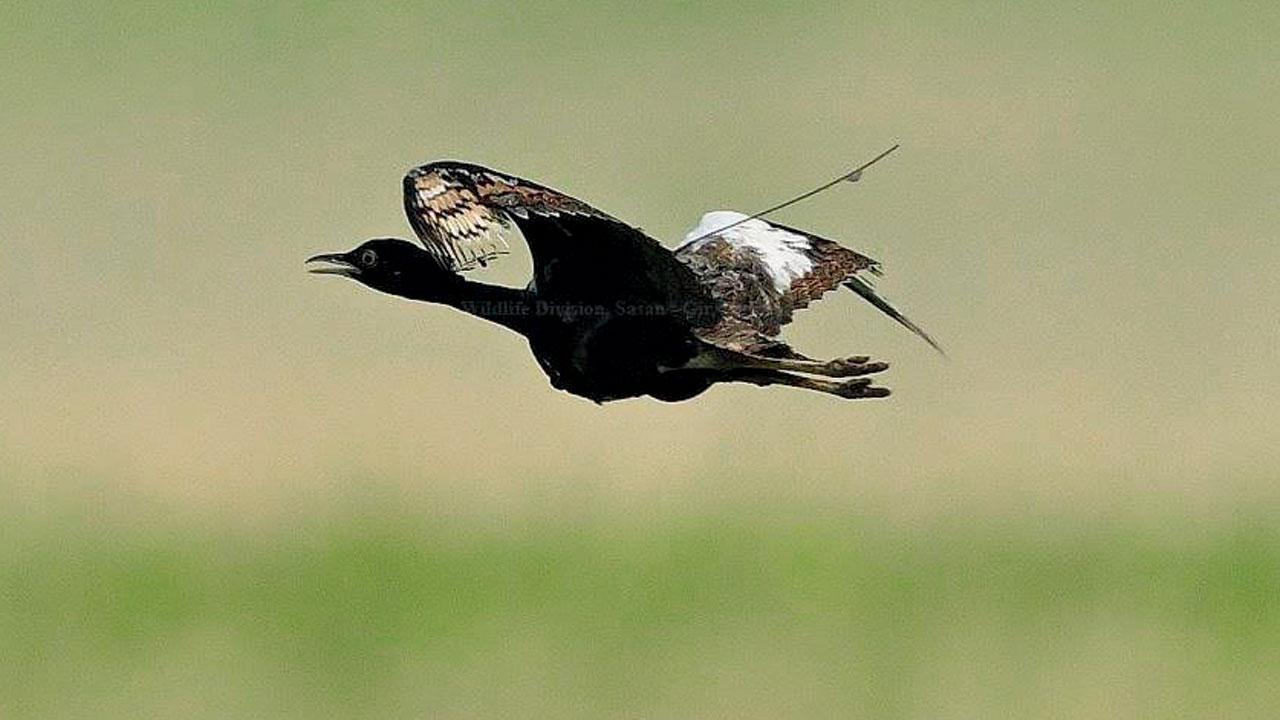Wildlife professionals gather critical data on migration routes and habitat choices of the lesser florican by tracking two of them

The lesser florican is endemic to the Indian subcontinent. PIC COURTESY: Gujarat Forest Department
The critically endangered lesser florican bird is endemic to the Indian subcontinent but has a population of just around 600 today. A recent scientific study that tracked two birds through satellite telemetry has provided significant insights into their migration routes and habitat choices between Gujarat and Maharashtra. Experts have emphasised the critical need to satellite tag lesser floricans and protect the ‘mystery’ bird.
The two satellite-tagged birds were tracked as they travelled from Gujarat to Maharashtra. The findings of the study have been published in a scientific report titled ‘Unravelling the secrets of lesser florican: a study of their home range and habitat use in Gujarat, India’. The report is authored by Mohan Ram, Devesh Gadhavi, Aradhana Sahu, Nityanand Srivastava, TahirAli Rather, Kapil Bhatia, Lahar Jhala, Yashpal Zala, Indra Gadhvi, Vidhi Modi, Dushyantsinh Jhala, Akshita Patel, Sneha Baraiya and Dhaval Devaliya. The study was undertaken by the Wildlife Division, Sasan-Gir, Gujarat Forest Department, and The Corbett Foundation.
The Corbett Foundation’s Kedar Gore, a wildlife conservationist, told mid-day that two lesser floricans migrated from the breeding area in 2022. According to the study, the first signs of migration were observed between October 29 and 30, 2022, when one bird — named LFM9 — travelled approximately 25 km southwards from Ratanpur village, Vallabhipur taluka to Golrama village, Umrala taluka of Bhavnagar district, Gujarat.

A map shows the routes taken by LFM9 (purple line) and LFM10 (blue line) during the migration from their breeding area in Gujarat to their non-breeding area in Maharashtra. PIC COURTESY: Ram et al 2023
LFM9 continued its southward journey in shorter distance segments of approximately 20 km until November 11, using stopovers in 16 villages distributed in two districts of Gujarat and 15 villages located in three districts of Maharashtra. “LFM9 crossed the Gulf of Cambay (also known as Gulf of Khambhat) between November 18 and 19, flying approximately 125 km in one attempt and settling in croplands near Gadaria village, Valsad taluka, Valsad district. Then, covering a distance of approximately 100 km in a single day, it crossed Gujarat between November 19 and 20 and entered Maharashtra on November 21, where it settled in croplands in proximity to an irrigation canal in Gargaon village, Wada taluka, Palghar district. By December 2, it had travelled approximately 300 km from the previous location in one day and reached Man taluka in the Satara district Of Maharashtra,” the study stated.
The study points out that during its migration, the other bird — named LFM10 — exhibited nomadic behaviour between November 15 and 26. “It then crossed the Gulf of Cambay on November 26-27 by flying approximately 95 km and entered Kalwan taluka, Nashik district after covering a distance of around 260 km from Gujarat in a single day. LFM10 used a total of 12 stopovers in four districts of Gujarat and 12 in three districts of Maharashtra during its migration,” the study mentions. LFM9 and LFM10 flew at elevations ranging from 176 m to 313 m and covered distances of 4.24 km to 116 km per day. In a month, the maximum distance covered by LFM9 was 2,029 km and by LFM10 was 3,505 km. The distances covered depended on the type of habitats they flew over and the availability of food.
Proactive protection
Welcoming the study, Gore said there is a need to satellite tag more birds and understand their lives to counter the damages done by human activity. “The lesser florican is endemic to India and has perhaps just 600 individuals surviving today. The radio telemetry of this ‘mystery’ bird provides important information about its migration routes and habitat choices. It is important to continue such research and deploy satellite tags on more birds to acquire in-depth information that will help devise long-term conservation strategies. There is not much time left as the birds are facing similar threats of habitat loss, anthropogenic disturbances and power line collisions, among others, as faced by the Great Indian Bustard. We need to learn from past mistakes and not let the lesser florican reach the same precarious situation as the Great Indian Bustard. Timely action in the interest of these species is a must.”
125 km
Distance covered by LFM9 in one attempt
 Subscribe today by clicking the link and stay updated with the latest news!" Click here!
Subscribe today by clicking the link and stay updated with the latest news!" Click here!










